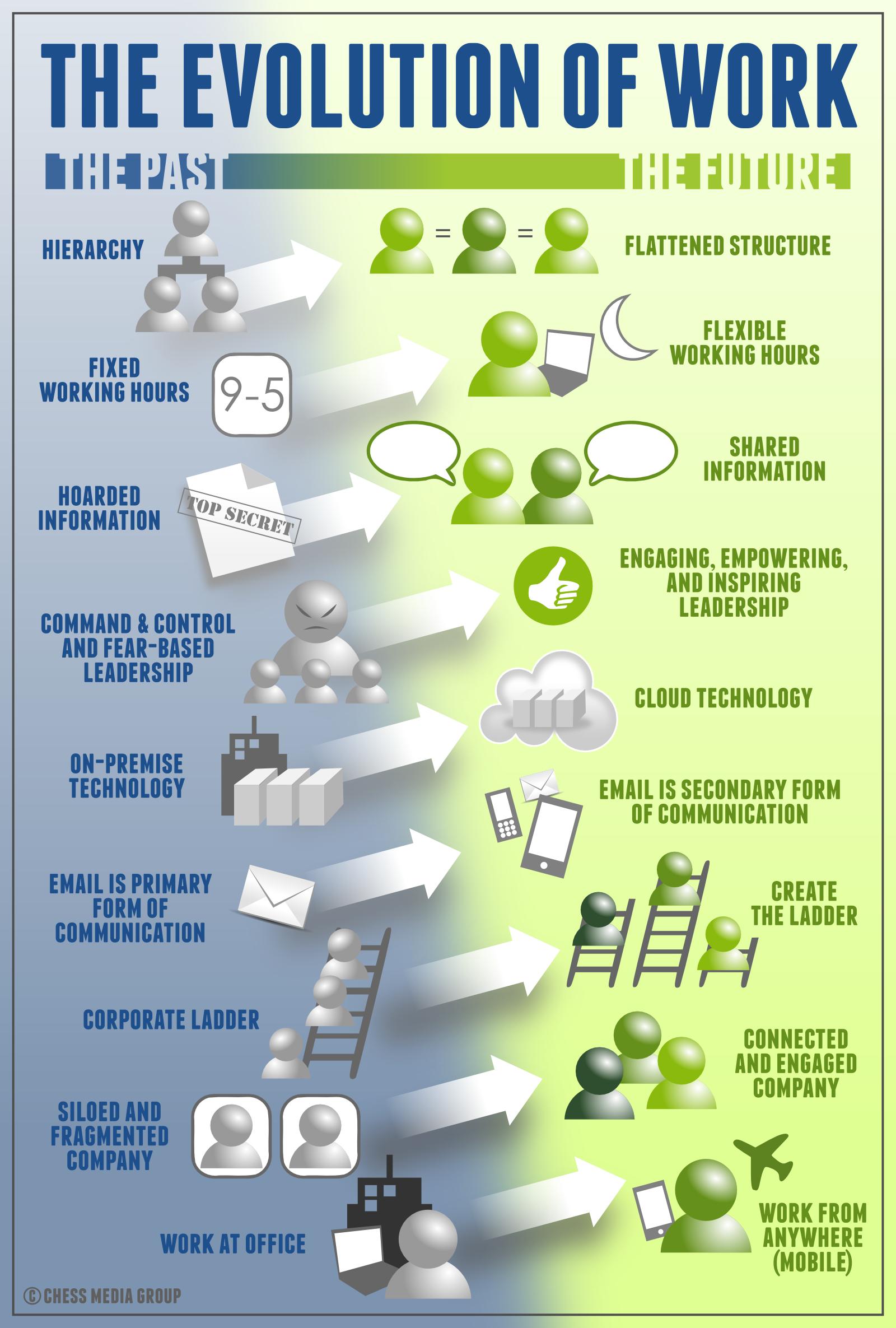9/10/2013
Work is clearly evolving which means that we are seeing new technologies and behaviours enter our organizations.
These newbehaviourss and technologies are largely being fueled by the consumer web and now organizations are struggling to adapt. Over the past few months, I explored the Five Trends Shaping The Future Of Work, The 5 Must-Have Qualities Of The Modern Manager, The 5 Must-Have Qualities Of The Modern Employee, and The 12 Habits Of Highly Collaborative Organizations. I highly recommend you check out those articles but I also wanted to create something which visually shows how exactly work is evolving and what areas are being impacted. To help do that my team from Chess Media Group and I put together a visual explaining the evolution of work. A high level explanation for each area is provided below after the graphic. Share it with your friends and colleagues who are seeking to understand how the world of work is changing.

From hierachies to a more flattened structure
Instead of the traditional hierarchical model, organizations are adoption a more flattened approach where anyone can speak with and interact with anyone else. There is no longer any justification for keeping people from interacting and engaging with each other because of their seniority level. New collaborative platforms are making this especially easy today.
From fixed working hours to flexible working hours
There’s no reason to force employees to work 9-5 anymore. Employees can now connect to people and information anywhere, anytime, and on any device. Working flexible hours makes the company more appealing to new hires, provides greater job satisfaction, and helps employees with work-life balance.
From hoarded information to shared information
Sharing information is part of what is driving the future of business. The successful and progressive companies understand that it’s crucial for employees to share their ideas, thoughts, and content. Employees also have the unique opportunity to become leaders by sharing what they know and what they care about. We do this every day in our personal lives on platforms such as Twitter,Facebook, and WordPress. New technologies for our organizations are making it much easier for employees to share relevant information with the right people. Hoarding is dead.
From fear-based leadership to empowering and inspiring
The smart leaders understand the concept of following from the front, that is, removing obstacles from the paths of employees to help them become successful. Scaring your employees into doing what you want is a failed approach to leadership yet unfortunately this is how many of our companies were created; it’s time to evolve this way of leading.
From on-premise to the cloud
Cloud technologies are rapidly making their way into our organizations, this means that it’s easier and cheaper to deploy social and collaborative tools to connect and engage our people and information. Not only that but many employees or team leaders are deploying these technologies without having to wait for corporate or IT approval.
From email as primary form of communication to being a secondary form of communication
I’m not saying email is dead but it is no longer the most effective way to communicate and collaborate with co-workers. Email today has become a glorified chat messaging program and we all stare at our in-boxes. If you don’t reply to an email within a few hours people get made at you, when did this become the norm? New collaborative technologies make it easier to collaborate, share, find, communicate, and engage with people and information. There’s no excuse for getting 200 emails a day anymore.
From climbing the corporate ladder to creating the ladder
Employees now have the unique opportunity to share their expertise, passions, and interests in a very public way (inside of their companies). This means that they can be recognized for their contributions, become subject matter experts, establish thought leadership, and ultimately shape their own career paths. Employees have a voice within their organizations that they never had before. There is no need to climb the corporate ladder, instead employees are building their own ladders.
From siloed and fragmented to connected and engaged
Most organizations are traditionally siloed and fragmented, employees in different departments or geographies don’t communicate and collaborate with one another, information isn’t shared, content is duplicated, and it’s impossible to find the right people and information to get work done. That’s now over. Organizations are working hard to break down barriers between teams and employees and this means adopting new behaviors which are supported and facilitated by new collaborative technologies.
From working at the office to working anywhere
As mentioned above employees now simply need to “connect to work.” This means that an employee can work from a home office, a coffee shop, or in a cab while on the way to the airport. Many organizations today have satellite offices staffed with just a single employee working from a home office or a co-working space.
This is the evolution of work
Jacob is the author of the Amazon best-selling book, The Collaborative Organization: A Strategic Guide to Solving Your Internal Business Challenges Using Social and Collaborative Tools (McGraw Hill).
